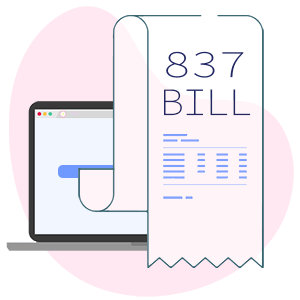How to e-Bill: Clearinghouse/Payer IDs Are Key to Quick Payment

We often hear from (non-client) providers who report that electronic billing simply doesn’t work.
However, data from our millions of quickly-paid e-bills proves that e-billing works beautifully when done right. So what causes e-billing to fail for some providers and not others?
The answer comes down to identifying and using the correct electronic “address” for the payer. This can be tricky, because an e-billing “address” consists of two components:
- The specific clearinghouse employed by the payer, and
- The Payer ID number assigned by the clearinghouse to the payer
This Clearinghouse/Payer ID combination is the e-billing “address,” and the key to successfully transmitting a workers’ comp e-bill. Unfortunately, many e-billing services fail to successfully manage the clearinghouse and Payer ID systems, leading to lost and unpaid e-bills.
Without fail, providers who assert that e-billing doesn’t work send their e-bills to the wrong address, which results in failure to obtain payment. Usually, these providers send all of their workers’ comp e-bills to a single clearinghouse — often not even a workers’ comp clearinghouse.
And of course, these providers do not have the knowledge or technology to navigate the complex Payer ID system.
Bottom line: Sending an e-bill to the wrong clearinghouse or with the wrong Payer ID results in failed e-billing and no payment.
Frequently, revenue cycle management (RCM) software and clearinghouses claim the ability to reroute your e-bills to the correct clearinghouse with the correct Payer ID. These claims are often false — as evidenced by unpaid or untimely paid bills.
In the video above and explanation below, see exactly how daisyBill e-billing software sends e-bills to the correct clearinghouse, using the correct Payer ID number. Additionally, we share our average days to payment as proof that e-billing works when done correctly.
837s: How To Send Compliant Workers’ Comp e-Bills
Workers’ comp providers must transmit e-bills in the required ANSI X12 837 EDI standard electronic format — called an ‘X12 837’ for short. E-billing software essentially “translates” the data providers would furnish on a paper billing form (like the CMS-1500) into data transmitted in an 837 file.
Creating the e-bill is only half the job, however.
Once the 837 file is ready, the e-billing software must transmit the 837 data to the correct “address.” This is where workers’ comp e-billing gets tricky.
Payer ID Numbers Explained: Transmitting 837 e-Bill Data
Fact: Most workers’ comp payers/claims administrators (including insurers, third-party administrators (TPAs), and self-insured employers) lack the necessary technology to accept e-bills in 837 format.
For that reason, these payers employ clearinghouses to accept provider e-bills on the payer’s behalf. Currently, workers’ comp payers mainly employ one of the following three clearinghouses:
- Jopari
- Data Dimensions (formerly WorkCompEDI)
- Carisk
This clearinghouse chosen by the payer assigns the payer a specific Payer ID number. To properly send an e-bill, the provider must send e-bills to the clearinghouse chosen by the payer, and use the correct Payer ID (the one assigned to the payer by the clearinghouse).
Data: How Correct e-Billing = Fast Payment
Below is a table of the top 20 claims administrators (aka payers) to which daisyBill sends e-bills on behalf of our provider clients, listed in order of the volume of e-bills our clients send to each.
Note that two of the claims administrators below do not use a clearinghouse, as each maintains the necessary technology to accept provider e-bills on their own:
- CorVel
- The US Department of Labor
Most importantly, notice the extremely low average days to pay for each payer. When e-bills are sent to the correct e-billing address with the correct Clearinghouse/Payer ID, e-bills are usually paid timely.
Claims Administrator |
Clearinghouse |
Payer ID(s) |
2021 daisyBill Bill Count |
Average Days To Pay |
Sedgwick Claims Management Services - TPA |
Data Dimensions |
Main Payer ID: WX867
Client-Specific Payer ID Count: 9 |
386,015 |
11 |
Gallagher Bassett |
Jopari |
TP057 |
135,991 |
8 |
State Compensation Insurance Fund (CA) |
Jopari |
35076 |
132,794 |
13 |
Liberty Mutual Insurance |
Jopari |
33600 |
71,128 |
8 |
Zurich Insurance North America |
Jopari |
16535 |
64,600 |
9 |
Berkshire Hathaway Homestate Companies |
Carisk |
E0679 |
56,441 |
12 |
Broadspire - TPA |
Carisk |
Main Payer ID: E8088
Client-Specific Payer ID Count: 4 |
54,612 |
9 |
ESIS Inc. - TPA |
Data Dimensions |
Main Payer ID : CQ200
Client-Specific Payer ID Count: 1 |
54,353 |
13 |
CorVel - TPA |
None |
Main Payer ID: None
Client-Specific Payer ID Count: 409* |
50,704 |
8 |
Tristar Risk Management - TPA |
Jopari |
Main Payer ID: 41556 |
49,426 |
12 |
AmTrust North America |
Availity |
12491 |
44,129 |
19 |
Intercare Holdings Insurance, Inc. - TPA |
Data Dimensions |
Main Payer ID: WB422
Client-Specific Payer ID Count: 6 |
41,356 |
9 |
Cannon Cochran Management Services Inc. - TPA |
Data Dimensions |
WR322 |
38,807 |
18 |
Athens Administrators - TPA |
Data Dimensions |
Client-Specific Payer IDs: 139 |
37,112 |
13 |
Insurance Company of the West |
Jopari |
27847 |
33,391 |
8 |
Department of Labor |
None |
77044 |
27,009 |
10 |
Keenan & Associates - TPA |
Data Dimensions |
Main Payer ID: WZ439
Client-Specific Payer ID Count: 1 |
21,684 |
10 |
The Zenith |
Jopari |
13269 |
19,991 |
9 |
AIMS - TPA |
Data Dimensions |
Client-Specific Payer IDs: 38 |
19,086 |
12 |
Adminsure - TPA |
Data Dimensions |
Main Payer ID: CB145
Client-Specific Payer ID Count: 6 |
18,538 |
8 |
Important Payer ID Notes
-
For internal purposes, TPAs often assign ‘client-specific Payer IDs.’ The TPA assigns a single self-insured client its own Payer ID that a provider must use when sending an e-bill for that self-insured client.
This “boutique” e-bill routing complicates matters for e-billing providers, because the provider must know the specific payer ID for the underlying self-insured employer. This requires specialized workers’ comp e-billing technology.
- CorVel maintains 409 Payer IDs, because this TPA acts as its own clearinghouse and assigns a different Payer ID number to each CorVel payer-client. e-billing requires the provider to use the correct Payer ID CorVel assigns to each of its clients (and yes, this also requires specialized workers’ comp e-billing technology).
-
Athens Administrators and AIMS both use a clearinghouse to accept e-bills from providers. These two TPAs do not maintain a Main Payer ID. Instead, both assign a different Payer ID number to each payer-client.
Both claims administrators require a provider to send a paper bill if there is no client-specific Payer ID assigned to the payer-client (this is theoretically disallowed in California, but welcome to California workers’ comp, where regulators routinely ignore payer noncompliance).
e-Billing Works — With the Right Tech & Expertise
Without a doubt, workers’ compensation e-billing is more complicated than Medicare or group health e-billing. But daisyBill data proves that e-billing works when done properly.
So how does daisyBill consistently, properly route each e-bill? We maintain a back-end database of every e-billing address for every claims administrator, including when the claims administrator maintains multiple Payer IDs.
With the appropriate claims administrator selected, daisyBill providers simply enter the information that would normally go onto a paper billing form. daisyBill then converts that information (and supporting documents) into the required electronic formats, and securely transmits it all using the correct clearinghouse/Payer ID combination.
In this way, daisyBill lifts the burden of keeping track of this information from providers, and ensures that every e-bill reaches its destination.
Protect your practice revenue. Harness the power of daisyBill software, data, and expertise for faster, better workers’ comp billing.
CONTACT US
DaisyBill provides content as an insightful service to its readers and clients. It does not offer legal advice and cannot guarantee the accuracy or suitability of its content for a particular purpose.




.png)
.gif)